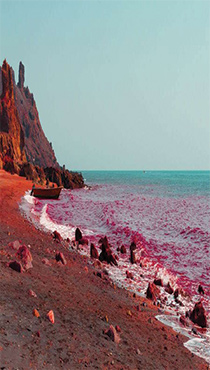Hormuz Island
One of an elliptical island in the Persian Gulf, that the distance from Bandarr Abass is 8 km and its surface is covered by sedimentary rock and layers is Hormuz Island. It is considered to be the key element of the Persian Gulf because of its geographical location and the closeness to the Strait of Hormuz. Due to this geographic location, throughout history, it has been strategically and commercially important. The island covers an area of almost 42 km2 with the highest altitude of 186 meters above the sea level. The small island is about 5 miles (8 km) off the Iranian Coast in the Hormozgan Province. On the sea route of Qeshm to this island mountains are seen in yellow, white and red. Among these mountains, there is a red mountain that is eatable and locals use its red soil as a spice to cook fish and bread and prepare pickles, jam and sauce. The entire of this island is made of rainbow mountains and you can freely walk through most of the middle of it. In close neighbourhood of Silence Valley, lies the mesmerizing valley of more than 70 shades of minerals, rendering the valley a perfect subject of Geology studies.The mineral colors of black, white, yellow, red, blue, make up a major landscape, every visitor whishes to see it. It is strongly recommended to visitors not to take any soil or rocks from the valley.

History
The island has changed during centuries. It was known as Organa to the ancient Greeks and as Jarun in the Islamic period. Its name changed to “Hormuz” from the important harbor town of Hormuz on the mainland. Marco Polo visited the island in 1290 while traveling by land, as he explained in his travelogue. Later, Ibn Battuta visited the island and New Hormuz. In the 15th century, it was visited several times by a Chinese fleet led by Zheng He, as he explored the Indian Ocean during the Ming Dynasty's naval ventures. In 1507, the Portuguese captured the island and it was incorporated into the greater Portuguese Empire. They constructed a fortress on the island to prevent potential invaders, naming it the Fort of Our Lady of the Conception. As a result, the island became an emergency stopover point for Portuguese ships traveling to Goa and Gujarat. Finally, the island was captured from the Portuguese by a combined Anglo-Persian force at the behest of the English East India Company in 1622.
During the Safavid Era, Shah Abbas I did not have trust in local people of the Hormuz Island. Later he developed the nearby mainland port of Bandar Abass to become the center of trade. Therefore, this island went into decline during that time and many of its inhabitants seasonally moved to their fields and orchards around the old this island. After a period of Omani administration in the 19th century, it remained a sparsely settled fishermen's island. It experienced some development in the later of the 20th century. Today, this island is the most visited in the southern of our country, especially during the fall and winter that the weather is pleasant.
Attractions of Hormuz Island
There are numerous places to visit in the island which totally depend on how much time you have to explore the area. Of course, you can easily see the main attractions one day. One of the fantastic attractions is Rainbow Valley, that is a geologist’s dream and an inspiration for artists and nature lovers. Imagine a narrow valley with multi-hued earth and sand and colourful mountains in shades of red, purple, yellow, ochre that, it stunningly beautiful natural site is called 'Valley of the Statues' because here tall rocks have been sculpted into strange shapes by the elements. Some 750m north of the harbour is the prominenet Portuguese sea fort, probably the most impressive and ambitious colonial fortress built in Iran. Salt Cascades is one of Hormuz's star attractions, these multicoloured geological formations that consist of cliffs and towers of petrified salt combined with different types of rock have a Tolkienesque appeal. About Snowy Mountains, that it's hard not to be enthralled by the creepy lunar landscape in the island's southwest, where a series of hills is covered with endless fields of salt crystals. The Silence Valley is where you will be definitely amazed by its beauty and great silence. To reach the place you need to walk a few hundred yards to enjoy the amazing mountains covered with crystalline salts. It is believed that the rock salt releases very positive energy, therefore, after spending some time in the area, you will surely have a great deal of energy. The last attraction is the Museum and Gallery of Dr. Ahmad Nadalian exhibit, that artwork of this environmental artist who is internationally renowned. Many of his works are in other museums around the world. His environmental art projects include the carving of rocks and paintings by natural colors.
Cuisine
The people of Hormuz have their own special way of cooking. They take the fresh fish of their waters, such as sardines, kilka and another kind called ‘momagh’, that clean them and marinate them in the peel of sour oranges and this particular sauce in a large container and leave it in the sun for two days. Then its cooked to become a delicious meal called ‘suragh’. Its appetizing taste and color is very popular among tourists from both Iran and abroad. Very few visitors to this island leave without having tasted the dish.
The same red soil is also used in baking the local bread called ‘tomshi’. The same bread is cooked in neighboring islands with cheese or dabbled with eggs; but Hormuz has its own special recipe made with ‘suragh’ which is rather popular. Guelak and suragh are also known in other parts of Hormuzgan Province and are used in foods such as ‘kalleh jush’ made with walnuts and whey, lentil rice, and small shrimps and other seafood.